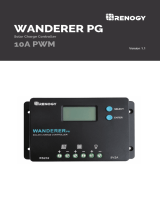Page is loading ...

www.renogy.com
USER GUIDELINE
LITHIUM IRON PHOSPHATE BATTERY
Danger
High Voltage
Eye Protection
Must Be Worn
Emergency
Eye Wash Risk Of Fire Highly
Flammable Material
Caution
ALWAYS wear protective
clothing and eyeglasses
while working with the
Lithium Iron Phosphate
Battery.
Any uncoverd battery
material such as electrolyte
or powder on the skin or in
the eyes must be flushed
out with plenty of clean
water immediately. Seek
medical attention
afterwards. Spillages on
clothing should be rinsed
out with water.
Terminals of the Lithium
Iron Phosphate Battery are
always live. DO NOT place
tools on them. DO NOT
short circuit or use outside
of the specified electrical
ratings.
DO NOT touch any
terminals or connectors to
avoid electric shock.
Safety Precautions
Please use circuit breakers, fuses, or disconnects that are appropriately sized by certified electricians, licensed installers, or
regional code authorities to protect all the electrical equipment in your system. The battery contains a battery management
system (BMS) that protects the battery cells from over-charge, over-discharge, and over-current, however this alone will not
protect your system from severe electrical conditions.
Please verify the polarity before connecting wiring. Reverse polarity can and will destroy the battery.
DO NOT short-circuit the battery terminals. Doing so can cause bursts in amperage and lead to irreversible damage to the
system and the battery (and possibly cause an explosion).
Please wear proper personal protective equipment when working on the battery.
DO NOT string batteries in series. Doing so can cause catastrophic failure.
Please ONLY connect identical batteries in parallel to ensure the best battery performance.
If the battery shuts off due to low state of charge, please disconnect the battery from your equipment to eliminate parasitic loads
and charge the battery as soon as possible.
It is highly recommended to pair the battery with low voltage disconnect devices in the system setup.
Renogy | www.renogy.com | [email protected] | T: 909-287-7111 | F: 888-543-1164

www.renogy.com
Battery Operation
Battery Storage
Battery Management System (BMS)
Depending on shipping times and the time since manufacture, the battery may be received at a partial state of charge. Please
fully charge the battery prior to the first use.
Use high stranded copper and heavy gauge cables to handle possible loads from the battery. Make sure to maintain identical cable
lengths.
Verify correctpolarity
Battery Installation
Safe and reliable installation requires trained and certified technicians. This section can only serve as a guideline as all scenarios
cannot be covered.
Wear protective clothing and eyeglasses
Size the battery cables appropriately
Renogy | www.renogy.com | [email protected] | T: 909-287-7111 | F: 888-543-1164
Reverse polarity can and will destroy the battery. Use a multimeter to determine proper polarity.
Tighten the cable connections
Please charge the battery to 30%~50% and store the battery in an open, well-ventilated, dry, clean area with temperatures of
around 23 (73.4 ).
The BMS will protect and shut the battery down when it is over-discharged or short circuited. In these rare cases, the battery will
show 0V voltage. Please activate the battery using an external charging source that has lithium battery activation function. Please
contact our Tech Support team at (909)287-7111 for more information about the BMS.
Long periods of storage can deteriorate the battery performance. It is recommended to charge the battery at least once every
three months to prevent over-discharge.
For standard discharging, the battery is discharged at 0.2C constant current until the battery reaches 20V. Safe discharging
requires temperatures between-20 and 60 -4 and 131 .
Standard charging consists of charging at 0.2C constant current until the battery reaches 29.0V. The battery is then charged at
a constant voltage of 29.0V while tapering the charging current. Charging is considered complete when the charging current has
tapered to 0.05C. Safe charging requires temperatures between 0 and 55 32 and 131 ) and takes approximately 5.5
hours.
Place the battery in a well-ventilated area
Over-tightening cable connections can cause terminal breakage and loose cable connections can cause terminal meltdown or fire.

www.renogy.com
Renogy | www.renogy.com | [email protected] | T: 909-287-7111 | F: 888-543-1164
Model
Electric
Characteristics
Charging
Parameters
Discharging
Parameters
Temperature
Parameters
Mechanical
Properties
Nominal Voltage
Rated Capacity0.2C
Energy
Specific Energy
Internal Resistance
Cycle Life
Charge Voltage
Maximum Continuous Charge Current
Charge Cut-off voltage
Maximum Continuous Discharge Current
Dimensions
25.6V
50Ah
1280Wh
100.78Wh/kg
≤20mΩ
50A
3500 Cycles 25 0.2CDOD 80%EOL 80%
29±0.2V
29.2V
Discharge Cut-off Voltage
Weight
Housing Material
Terminal Model
Assembly Method
Operation
Temperature
Range 60±25% R.H.
Storage
Temperature
Range 60±25% R.H.)
Charge
Discharge
Recommended
Length
Width
Height
0~55 /32~131
-20~60 /-4~140
23±5 /73.4±9
330mm/13.0inch
172mm/6.8inch
214mm/8.4inch
12.7kg/28.0lbs
M8 x 1.25 x 15mm
8S1P
-25~65 /-13~149
ABS (Flame Retardant Plastic)
20V
Battery Specifications
50A
RBT2450LFP

www.renogy.com
Renogy | www.renogy.com | [email protected] | T: 909-287-7111 | F: 888-543-1164
Battery Operation Status
Battery Overvoltage
Battery Cell Overvoltage
Battery Undervoltage
Trigger
Protection
Protection
Battery Voltage≥29.2V
Battery Voltage≤27.6V / Discharge current≥1A
Battery Cell Voltage≥3.65V
Battery Cell Voltage≤3.45V / Discharge current≥1A
Battery Voltage≤20V
Battery Voltage≥22.4V / Charge current≥1A
Recover
Trigger
Recover
Protection
Trigger
Recover
Protection Circuit Module PCMSpecifications
Battery Cell Undervoltage
Battery Cell Voltage≤2.5V
Battery Cell Voltage≥2.8V / Charge current≥1A
Protection
Trigger
Recover
Charge High Temperature
Battery Temperature≥131 55
Battery Temperature≤113 45
Protection
Trigger
Recover
Disharge High Temperature
Battery Temperature≥140 60
Battery Temperature≤122 50
Protection
Trigger
Recover
Charge Low Temperature
Battery Temperature≤32 0
Battery Temperature≥41 5
Protection
Trigger
Recover
Discharge Low Temperature
Battery Temperature≤-4 -20
Battery Temperature≥-5 -15
Protection
Trigger
Recover
Charge Overcurrent
Charge Current≥55A Delay 15s
Delay 1min
Protection
Trigger
Recover
Short circuit
Disharge Current≥1000A
Remove Short Circuit 300μs
Protection
Trigger
Recover
Discharge Overcurrent
Disharge Current≥55A Delay 15s
Delay 1min
Primary
Protection
Secondary
Protection
Trigger
Recover
Disharge Current≥60A Delay 250ms
Delay 1min
Trigger
Recover
Condition
/

